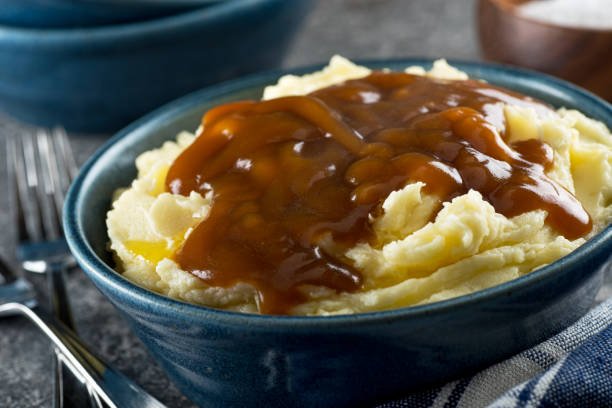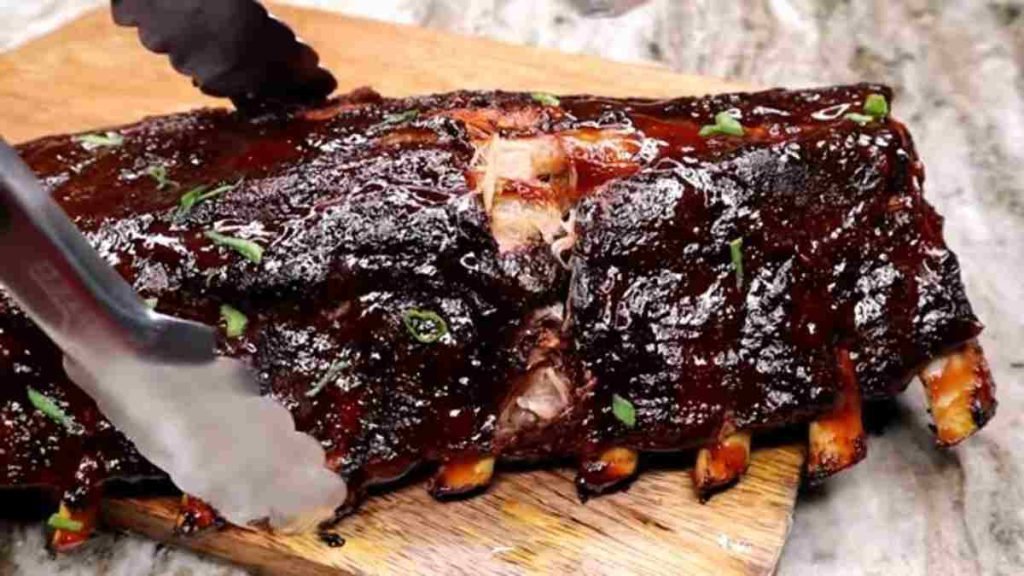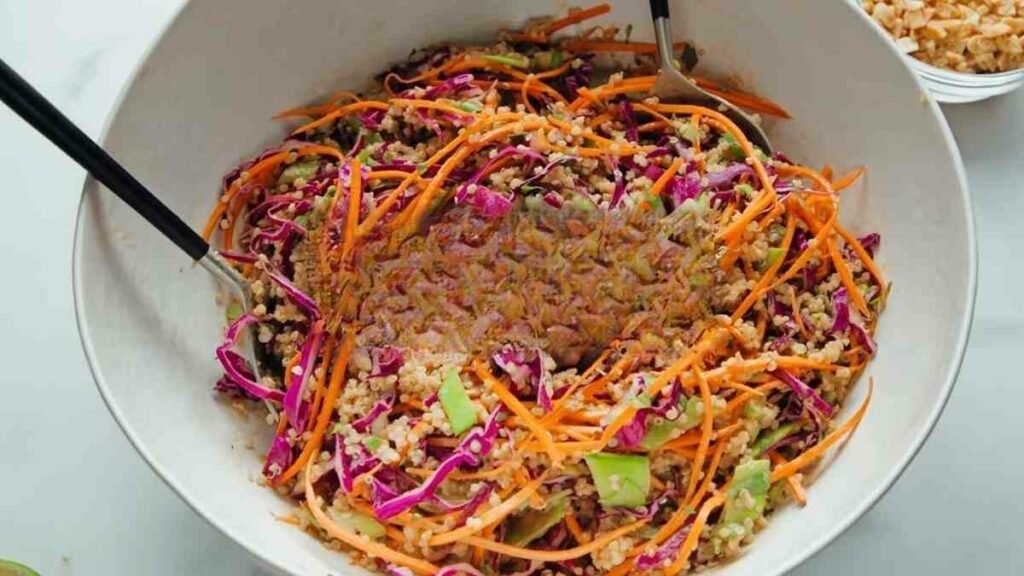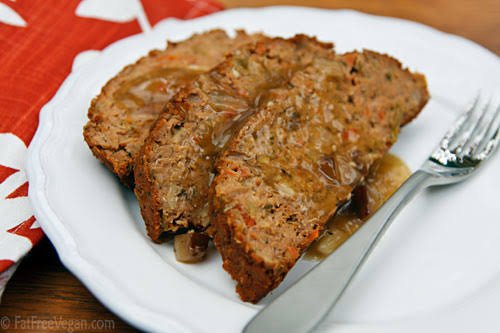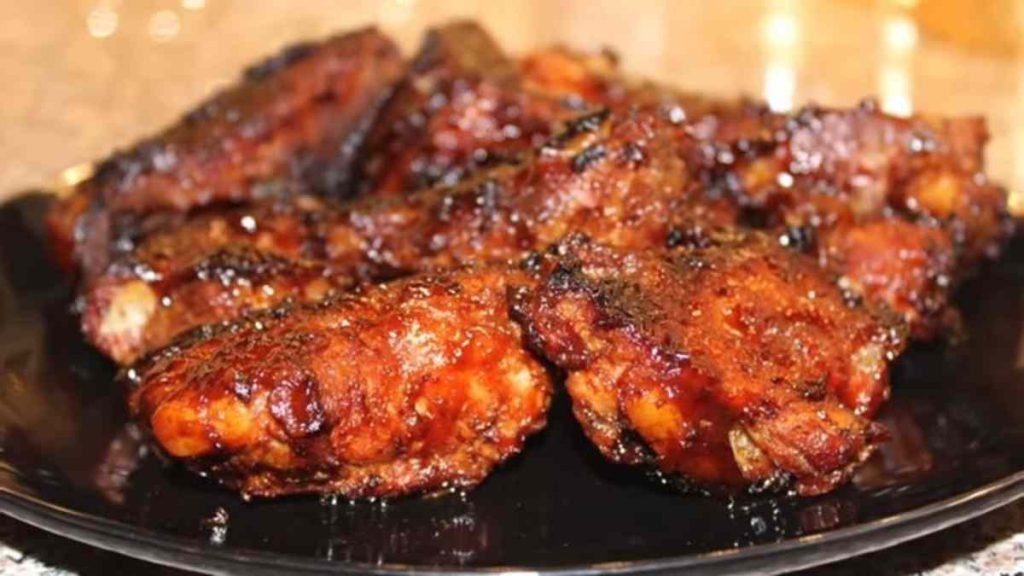The history of Vegetarian Pastitsio may not be as ancient as its meat-based counterpart, but its emergence showcases the adaptability of Greek cuisine to accommodate diverse dietary preferences. Vegetarian Pastitsio retains the essence of the original dish while introducing innovative plant-based elements that delight the taste buds. Instead of meat, this vegetarian rendition incorporates flavorful ingredients such as lentils, chickpeas, or textured vegetable protein (TVP) to provide a satisfying protein-rich base.
Vegetarian Pastitsio offers several other unique selling points that appeal to health-conscious individuals and environmentally-conscious food enthusiasts. By replacing meat with plant-based proteins, it offers a lighter and more cholesterol-friendly option that is rich in nutrients, fibre, and antioxidants.
Ingredients For Vegetarian Pastitsio Recipe
To prepare a delicious Vegetarian Pastitsio, you will need the following major ingredients:
Pasta:
- 1 pound (450 grams) of penne pasta or any other tubular pasta of your choice
Tomato Sauce:
- 2 tablespoons olive oil
- 1 medium onion, finely chopped
- 3 cloves garlic, minced
- 1 can (14 ounces or 400 grams) of diced tomatoes
- 1 can (6 ounces or 170 grams) tomato paste
- 1 teaspoon dried oregano
- 1/2 teaspoon ground cinnamon
- Salt and pepper to taste
Vegetarian Protein Base:
- 1 cup cooked lentils or chickpeas, or 1 cup rehydrated textured vegetable protein (TVP)
Vegetable Layer:
- 2 tablespoons olive oil
- 1 medium eggplant, sliced into 1/4-inch thick rounds
- Salt and pepper to taste
Béchamel Sauce:
- 4 tablespoons unsalted butter or vegan butter substitute
- 1/4 cup all-purpose flour or gluten-free flour blend
- 2 1/2 cups milk (dairy or plant-based)
- 1/2 teaspoon ground nutmeg
- Salt and pepper to taste
- 1/2 cup grated Parmesan cheese or vegan Parmesan substitute (optional)
Topping:
- 1/4 cup grated Parmesan cheese or vegan Parmesan substitute
- 1/4 cup breadcrumbs (regular or gluten-free)
- 1 tablespoon melted butter or olive oil
Optional Garnish:
- Fresh parsley, chopped
Step-by-Step Guide Vegetarian Pastitsio Recipe Cooking Direction
To cook your vegetarian pastitsio follow these steps:
Step 1: Cook the Pasta
- Bring a large pot of salted water to a boil. Add the pasta and cook according to the package instructions until al dente. Drain the cooked pasta and set aside.
Step 2: Prepare the Tomato Sauce
- In a large saucepan, heat 2 tablespoons of olive oil over medium heat. Add the chopped onion and minced garlic, and sauté until they become translucent and fragrant about 3-4 minutes. Add the diced tomatoes, tomato paste, dried oregano, ground cinnamon, salt, and pepper. Stir well to combine all the ingredients. Reduce the heat to low and let the sauce simmer for about 15-20 minutes to allow the flavours to meld together.
Step 3: Prepare the Vegetarian Protein Base
- If using dried lentils or chickpeas, cook them according to the package instructions until tender. If using textured vegetable protein (TVP), rehydrate it in hot vegetable broth or water for about 10 minutes, then drain any excess liquid. Add the cooked lentils/chickpeas or rehydrated TVP to the tomato sauce and mix well. Allow the mixture to simmer for an additional 5 minutes to ensure everything is well combined. Set aside.
Step 4: Prepare the Vegetable Layer
- Preheat your oven to 400°F (200°C). In a large skillet, heat 2 tablespoons of olive oil over medium heat. Add the sliced eggplant rounds in a single layer, season with salt and pepper, and cook until golden brown on both sides, about 2-3 minutes per side. Repeat until all the eggplant slices are cooked. Set aside.
Step 5: Prepare the Béchamel Sauce
- In a separate saucepan, melt 4 tablespoons of unsalted butter over medium heat. Once melted, add the flour and whisk continuously for about 2 minutes to create a roux. Gradually pour in the milk while whisking continuously to prevent lumps from forming. Add the ground nutmeg, salt, and pepper. Continue whisking until the sauce thickens and coats the back of a spoon. Remove from heat and stir in the grated Parmesan cheese (if using), allowing it to melt into the sauce. Set aside.
Step 6: Layering the Vegetarian Pastitsio
- In a 9×13-inch baking dish, spread half of the cooked pasta in an even layer. Next, add the vegetable layer by placing the cooked eggplant slices on top of the pasta, covering it completely. Pour the tomato and vegetarian protein mixture over the eggplant layer, ensuring it is evenly distributed. Finally, pour the prepared béchamel sauce over the top, spreading it out to cover the entire dish.
Step 7: Topping and Baking
- In a small bowl, combine the grated Parmesan cheese (or vegan substitute) and breadcrumbs. Sprinkle this mixture evenly over the béchamel sauce. Drizzle the melted butter (or olive oil) over the top.
- Place the baking dish in the preheated oven and bake for 35-40 minutes, or until the top is golden brown and bubbling. Remove from the oven and let it rest for 10-15 minutes before serving.
Step 8: Serve and Enjoy
- Garnish with freshly chopped parsley, if desired. Cut the Vegetarian Pastitsio into squares or rectangular portions and serve warm. It pairs wonderfully with a Greek salad or a side of roasted vegetables.
Equipment For Preparing Vegetarian Pastitsio Recipe
To make Vegetarian Pastitsio, you will need the following equipment:
- Large Pot: A large pot is necessary for boiling the pasta. Choose one with a capacity that comfortably accommodates the amount of pasta you’re cooking.
- Strainer: A strainer or colander is essential for draining the cooked pasta after boiling.
- Large Saucepan: You’ll need a large saucepan to prepare the tomato sauce and combine it with the vegetarian protein base. Opt for a saucepan with a thick bottom for even heat distribution.
- Skillet: A skillet or frying pan is required to cook the eggplant slices for the vegetable layer. Choose one that is wide enough to fit the eggplant rounds without crowding.
- Baking Dish: A 9×13-inch baking dish is ideal for assembling and baking the Vegetarian Pastitsio. Make sure the dish is oven-safe and has sufficient depth to accommodate the layers of pasta, sauce, and toppings.
- Whisk: A whisk is useful for blending the ingredients when preparing the béchamel sauce and ensuring a smooth consistency. A balloon whisk or wire whisk works well for this purpose.
- Wooden Spoon or Spatula: A wooden spoon or spatula is handy for stirring and combining the ingredients in various steps of the recipe, such as sautéing the onion and garlic, mixing the tomato sauce, and incorporating the vegetarian protein base.
- Oven: An oven is essential for baking the assembled Vegetarian Pastitsio. Ensure that your oven is preheated to the specified temperature mentioned in the recipe.
- Mixing Bowl: A mixing bowl is useful for combining the grated Parmesan cheese (or vegan substitute) and breadcrumbs for the topping.
- Small Bowl: You’ll need a small bowl for melting the butter or olive oil to drizzle over the topping.
- Chef’s Knife: A sharp chef’s knife is necessary for slicing the eggplant and any other vegetables you may choose to add to the dish.
- Cutting Board: A cutting board provides a stable surface for chopping and slicing the ingredients.

Vegetarian Pastitsio Recipe
Ingredients
- 1 pound (450 grams) of penne pasta or any tubular pasta
- 2 tablespoons olive oil
- 1 medium onion, finely chopped
- 3 cloves garlic, minced
- 1 can (14 ounces or 400 grams) of diced tomatoes
- 1 can (6 ounces or 170 grams) tomato paste
- 1 teaspoon dried oregano
- 1/2 teaspoon ground cinnamon
- Salt and pepper to taste
- 1 cup cooked lentils or chickpeas, or 1 cup rehydrated textured vegetable protein (TVP)
- 2 tablespoons olive oil
- 1 medium eggplant, sliced into 1/4-inch thick rounds
- 4 tablespoons unsalted butter or vegan butter substitute
- 1/4 cup all-purpose flour or gluten-free flour blend
- 2 1/2 cups milk (dairy or plant-based)
- 1/2 teaspoon ground nutmeg
- Salt and pepper to taste
- 1/2 cup grated Parmesan cheese or vegan Parmesan substitute (optional)
- 1/4 cup grated Parmesan cheese or vegan Parmesan substitute (for topping)
- 1/4 cup breadcrumbs (regular or gluten-free)
- 1 tablespoon melted butter or olive oil (for topping)
- Fresh parsley, chopped (for garnish)
Instructions
- Cook the pasta according to package instructions until al dente. Drain and set aside.
- In a large saucepan, heat 2 tablespoons of olive oil over medium heat. Sauté the chopped onion and minced garlic until translucent and fragrant.
- Add the diced tomatoes, tomato paste, dried oregano, ground cinnamon, salt, and pepper to the saucepan. Stir well and simmer for 15-20 minutes.
- Add the cooked lentils/chickpeas or rehydrated TVP to the tomato sauce. Allow the mixture to simmer for an additional 5 minutes. Set aside.
- Preheat the oven to 400°F (200°C). In a skillet, heat 2 tablespoons of olive oil over medium heat. Cook the eggplant slices until golden brown on both sides. Set aside.
- In a separate saucepan, melt the butter over medium heat. Whisk in the flour and cook for 2 minutes. Gradually pour in the milk, whisking continuously. Add the ground nutmeg, salt, and pepper. Continue whisking until the sauce thickens. Remove from heat and stir in the grated Parmesan cheese (optional).
- In a 9×13-inch baking dish, layer half of the cooked pasta. Arrange the cooked eggplant slices on top. Pour the tomato and vegetarian protein mixture over the eggplant layer. Pour the prepared béchamel sauce over the top.
- In a small bowl, combine the grated Parmesan cheese (or vegan substitute) and breadcrumbs. Sprinkle this mixture evenly over the béchamel sauce. Drizzle the melted butter (or olive oil).
Video
Tips & Tricks for the Perfect Vegetarian Pastitsio Recipe
These expert tips will help you to prepare the best vegetarian recipe.
1. Choose the Right Pasta
Opt for tubular pasta, such as penne or ziti, as they hold up well in the dish and provide a satisfying texture. Cook the pasta al dente to ensure it doesn’t become mushy during baking.
2. Salt the Pasta Water
When boiling the pasta, be sure to salt the water generously. This adds flavour to the pasta itself, enhancing the overall taste of the dish.
3. Season Each Layer
To build depth of flavour, season each component of the Vegetarian Pastitsio. Season the tomato sauce, the vegetable layer, and the béchamel sauce with salt, pepper, and spices like oregano and cinnamon. Taste and adjust the seasoning as needed.
4. Enhance the Tomato Sauce
Consider adding a touch of sweetness to the tomato sauce by incorporating a teaspoon of sugar or a drizzle of honey. This balances the acidity and intensifies the flavours.
5. Sauté the Eggplant
When cooking the eggplant for the vegetable layer, ensure that it is well-seasoned and cooked until golden brown. This adds a caramelized flavour and prevents the eggplant from becoming soggy in the final dish.
6. Experiment with Vegetables
While eggplant is a traditional choice for the vegetable layer, feel free to explore other vegetables such as zucchini, bell peppers, or mushrooms. These additions can contribute additional flavours and textures to the dish.
What to Take With Vegetarian Pastitsio
Greek baked pasta dish layered with creamy bechamel sauce and savoury filling food that deserves complementary side dishes to get a satisfying meal.
- Greek Salad
- Roasted Vegetables
- Tzatziki Sauce and Pita Bread
- Sautéed Greens
- Garlic Bread
- Lemon Potatoes
- Steamed Asparagus
- Crisp White Wine
How to Store Vegetarian Pastitsio
Whether you have leftovers or you’re planning to make it in advance, knowing how to store vegetarian pastitisos properly is essential.
1. Cooling and Handling
After cooking your vegetarian pastitsio, allow it to cool slightly. It’s important not to leave it at room temperature for too long to prevent bacterial growth. Once it’s no longer steaming, proceed to store it.
2. Portioning
Consider portioning the pastitisio before storing it. This allows you to reheat and consume only what you need, reducing waste and ensuring the remainder stays fresh.
3. Freezing for Extended Storage
For longer storage, freezing is the best option. You can either freeze the entire dish or portion servings. Use freezer-safe containers or wrap them tightly in plastic wrap and aluminium foil. Be sure to remove as much air as possible to prevent freezer burn.
4. Reheating
When you’re ready to enjoy your stored pastitis, you can reheat it in the oven at a low temperature to maintain its texture and flavours. If reheating individual portions, microwave them for a quicker meal.
Can I Substitute the Eggplant With Other Vegetables?
Eggplant serves as a traditional ingredient, but it can be substituted with various other vegetables to accommodate personal preferences or dietary needs. Potential alternatives include zucchini, mushrooms, bell peppers, spinach, cauliflower, carrots, or even a blend of these options.
Each vegetable offers unique flavours and textures, allowing for a versatile and customizable experience when preparing this Greek-baked pasta dish. The choice of substitute largely relies on personal taste preferences, as these vegetables can introduce different dimensions, from sweetness to heartiness, adding a diverse touch to the meal.
Can I Use a Different Protein Source?
You can use a different protein source in your vegetarian pastitsio. While the traditional pastitsio typically features ground meat like beef or lamb, many variations and adaptations exist to cater to different dietary preferences and restrictions.
For a vegetarian twist, you can use protein-rich ingredients such as tofu, tempeh, or seitan as meat substitutes. These alternatives can be seasoned and prepared to mimic the texture and flavours of traditional meat, providing a hearty and satisfying protein source.





